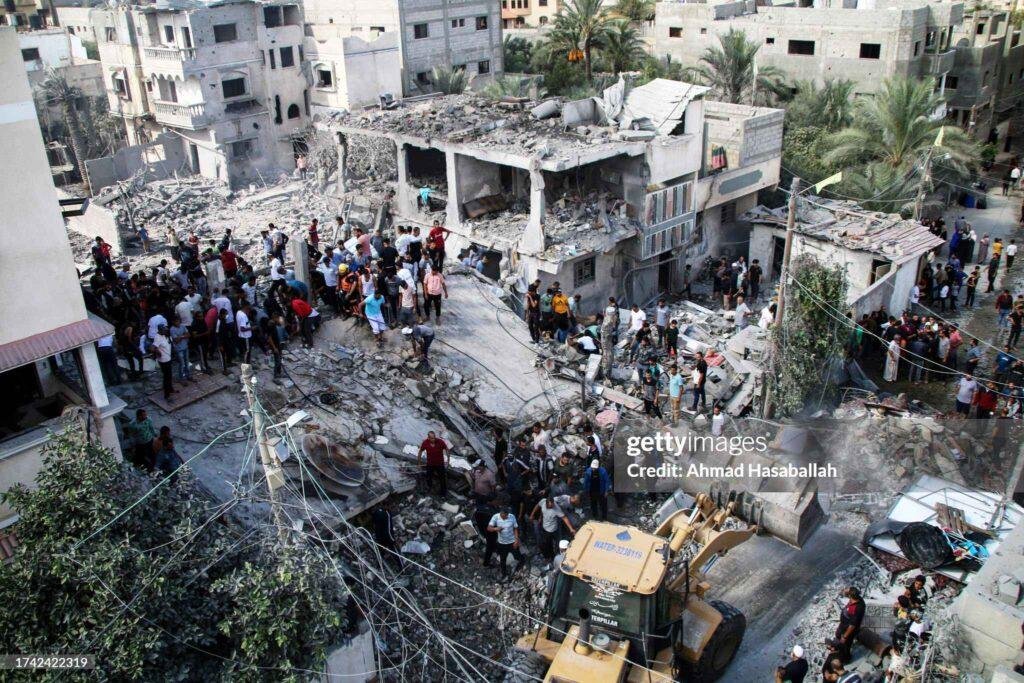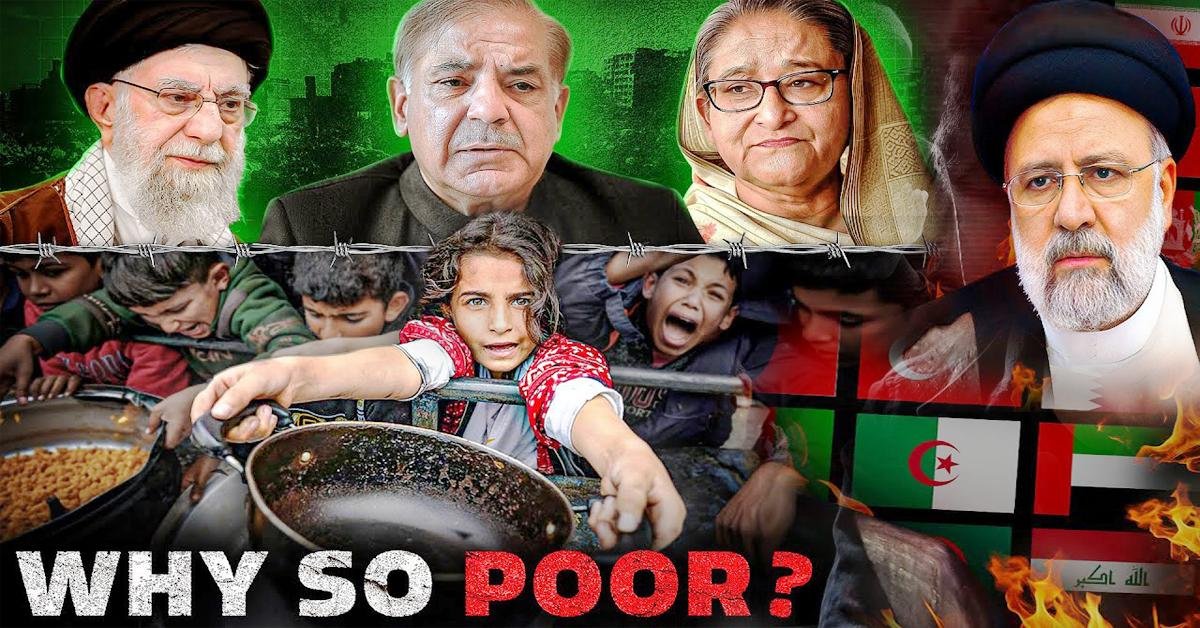Countries like Pakistan, Afghanistan, Syria, Mali, and Somalia share two distinct characteristics: first, their population is between 40 and 90% Muslim, and second, they are all Islamic countries. Only eight countries within the Organization of Islamic Cooperation, an organization of 57 Muslim countries, fall into the high-income category, and that too thanks to oil. Meanwhile, 34 Muslim countries in the world are currently facing starvation. How did the Islamic world, which had 500 years of prosperity, fall into a cycle of poverty and destruction? Is religion, British plunder, or other reasons behind this?
Chapter 1
The Golden Age of Islam: Prophet Muhammad, wearing a sari, gradually spread to East Central Asia, Africa, North America, and Europe. Abbasid Caliph Abu Ja’far al-Mamun was born in 786 AD. Under his rule, the city of Baghdad in Iraq was at a stage of prosperity. The learned ruler al-Mamun established the House of Wisdom, where the world’s knowledge was translated into Arabic. Al-Farmi became the center. He laid the foundation of algebra. He revolutionized medicine. Ali gave philosophy a new lease on life. However, in 1258, the Mongol invasion destroyed Baghdad. The House of Wisdom was set on fire. So many books were thrown into the River Tigris that the ink turned the river black.

Chapter 2
The Decline of Islamic Gambling: There are seven major factors behind the precarious state in which Muslim countries find themselves today. The first, Ali, who took the hand of Muhammad and declared that whatever he was the master of, was Ali. After Prophet Muhammad, he took the lead in leading Muslims. He upheld the rule of a capable person. He today controls 85 to 90% of the world’s population and 10 to 15% of the world’s population. He leads Saudi Arabia. Even today, the battle between Shias and Sunnis to establish dominance in Islamic countries continues. The second factor is that interest on loans is forbidden. This has led to economic backwardness. According to the series, it is forbidden to charge interest on loans. Banks were established in Europe in 1800. The first Ottoman Bank opened in the Middle East. Muslim countries established Islamic banking. It started a system where the bank also shares in the profits and losses. Many banks closed due to losses. Today, there is a completely Islamic banking system.
Third Factor
Muslim countries lag in science and technology. Despite having 25% of the world’s Muslim population, only three Islamic countries have received the Nobel Prize in Science, while Jews, who constitute less than 1% of the world’s population, have received 165 Nobel Prizes. Many Islamic countries oppose Charles Darwin’s Theory of Evolution. Politics and education were affected after the Golden Age. The printing press also arrived late, and education is also taught in madrasas.

Fourth Factor
Due to civil war over the demand for democracy, only Turkey was among the least corrupt countries in 2010, while most of the corruption was predominantly Muslim. After the Spring, most movements failed, and civil war and terrorism spread in many countries. 90% of Australia’s population and 80% of Yemen’s population are below the poverty line. 7 of the 10 countries at the bottom of the development index are Islamic, mostly in Africa. Sufi saints and merchants spread Islam in poor and backward areas. The sixth factor is that when European powers came to Islamic countries, they destroyed their economy, looted resources, and imposed slavery in African countries. Islamic countries have not been able to emerge to date. The last factor is that the lack of agriculture and strategic location are problems in Islamic countries. However, it is not true that all Muslim countries are poor. Saudi Arabia is also a rich country. Therefore, it is not right to blame religion for the poverty and destruction of Muslim countries. History, geography, and politics are bigger factors behind this.
Was the attack on October 7 Hamas’ biggest mistake? Israel searched and killed leaders through tunnels, 80% of Gaza in ruins
On the morning of October 7, 2023, exactly two years ago, thousands of our soldiers entered Israel. They brutally killed approximately 1,200 people, paraded women naked, and took 251 people to Gaza. This conflict has impacted six Middle Eastern nations. Two years have passed since the start of our war. Was the October 7 attack Hamas’s biggest mistake?
In 1987, cleric Sheikh Ahmed Yassin established Hamas. The movement wanted to bring Islam to Palestine and destroy Israel. Hamas chose to fight for this reason. In 2006, when they freed 1,000 Palestinian prisoners in exchange for a soldier, their courage increased.
They also received support from Iran and Turkey. In 2021, not only Hamas, but Israel also fired approximately 4,000 rockets at Israel. The conflict continued for days. On October 7, 2020, it launched its biggest attack on Israel, and from here the story changed. But why did Hamas launch such a big attack? Kabir Taneja, an expert on Middle East affairs, explains three major motives behind the attack. First, to draw the attention of Arab countries to the Palestine issue, second, to mobilize the international community, and third, to negotiate with Israel based on the hostages. Today, two initial objectives were achieved, but Israel was so powerful that it did not expect it. Israel destroyed Gaza and eliminated all of Hamas’s leadership. In the last two years, more than 65,000 Palestinians have died in Gaza, and more than 167,000 have been injured.22% of the total population, 4.7 lakh people, are facing the threat. 90% of Gaza’s 2.1 million population has been displaced. 80% of Gaza’s infrastructure and 98% of cultivable land have been destroyed. Of the 22 health care centers started by UNRWA, only four are in working condition. Israel also selectively purified Hamas’ top leadership during this time. A drone attack claimed the life of Hamas deputy Saeed al-Arab on January 2, 2024. Mohammad Daff, the leader of Hamas Sayya, was killed in an airstrike on July 13, 2024.

On July 31, 2024, Hamas’s political chief Smail Haniyan also died in Tehran. On October 16, 2024, Hamas’s Aya Saturday died in a deserted building in Central Gaza. On 14, 2025, Hamas’s Mohammad Sinwar died in a hospital tunnel. Now, know what the current situation of Hamas is. Today, we have lost more than 20,000 fighters along with our main commanders. Due to the devastation caused by the war, the pressure on us from the Palestinian people is also increasing. More than 15,000 fighters are said to be hiding in tunnels and attacking Israeli soldiers in a guerrilla manner. Currently, leaders like Khaled Mashal and Khalil al-Hariyya are in command of the society. US President Donald Trump has warned Israel that A 20-point peace plan was prepared for the ceasefire between the two communities. Both sides have agreed on it, after which a meeting was held between representatives of Israel and Hamas in Egypt on Monday. The ceasefire that is currently being discussed is to stop the conflict that started on October 7. The real fight is to make Palestine a separate country, for which Israel does not seem to agree. It will take a long time to resolve this issue
What is special about the AMRAAM missiles that Pakistan is receiving?
The shipment of AMRAAM missiles to Pakistan has received approval from the United States. The missiles are thought to improve Pakistan’s American F-16 fighter jets already in its possession. What makes these missiles unique, and is it possible that India should be concerned about them? The United States has granted Pakistan, a neighbor of India, permission to acquire M120 C8 advanced missiles.
These missiles are also called AMRAHAM. It is believed that these missiles will make the American F-16 Ladakh aircraft already present in Pakistan more powerful. The full name of AMRAHAM is Advanced Medium Range Missile, and it can attack from air to air, that is, it can be launched from the aircraft itself. It is used with air fighter jets like F-1.6, and its specialty is that it is considered autonomous and can guide itself towards the target. BBC correspondent Farhat Jave and Shantanu are giving more information about this deal from Islamabad. Pakistan has become a part of a new defense deal which is with the American defense company that manufactures the AMRAHAM missile system, a medium-range and long-range weapon system. This AMRAHAM system is used in the F-16 fighter system of the Air Force, and this AMRAHAM system is known for its accuracy and performance. At present, Argebali is the most sophisticated missile in the world. Among these systems, it is considered to be one that can operate in all types of weather, day and night, and even beyond visual range. This defense deal is very important for Pakistan. It also proves that the defense ties between Pakistan and Washington are improving. For Pakistan, this deal could also mean that the capabilities of Pakistan’s Air Force will improve. The importance of a highly reliable system is evident.

Pakistan had previously acquired earlier versions of this missile system from the United States in 2007. India had claimed that Pakistan had targeted Indian aircraft with its F-16s and this variant of these missiles during the 2019 conflict between India and Pakistan. At the time, Pakistan had denied this claim and stated that no F-16s were utilized. Pakistan had claimed, for the first time, that it had targeted Indian aircraft with the Chinese F-15 missile system. There is an agreement between Pakistan and it, according to which this new weapon system will be delivered to Pakistan around 2030. All this has happened at a time when relations between India and America are strained. Firstly, the trade deal is stuck, and then America has imposed a huge 50-rupee imposition on India. US President Donald Trump has also shown a lot of levy on Pakistan. Pakistan’s PM Shahbaz Sharif and Field Marshal Asif Munim have also met US President Donald Trump. So, is this a routine deal of America with Pakistan? Is there some message in it for India some time ago? I asked this question to defense expert Rahul Bedi. This is a very big deal; it is a deal of about 140 billion dollars, and 35 countries are involved in it, including Japan, Germany, Belgium, Saudi Arabia, Turkey, Pakistan, and Israel. So, it seems to me that although it has not been specified how many missiles Pakistan will get, Pakistan is getting a little fever out of turn, and the capability of this missile will increase to a great extent. And this will be operationalized on Pakistan’s F-16. The way Pakistan is getting these sophisticated weapons with the help of America, America’s air defense system is believed to strengthen India over Pakistan. Can this increase India’s worries? How should India look at this? India does not have so many capable missiles today. India has about three missiles.
The first is a French missile called Mithi, the second is an Israeli missile called Derby, and the third is a commercial missile called Ashram Part 1 from Atmanirbhar. Therefore, they have a range of about 100, 120, or 130 kilometers. It has a range of about 10 kilometers. The second feature of this M120 missile is that it creates a no-escape zone for the targets. This means that once it logs on to the target, it will not leave the target; its mission is completed only after destroying it. So, India does not have any such missile system. So, India’s Indian Air Force will have to be informed about this, and they will have to find a counter to it very quickly.
